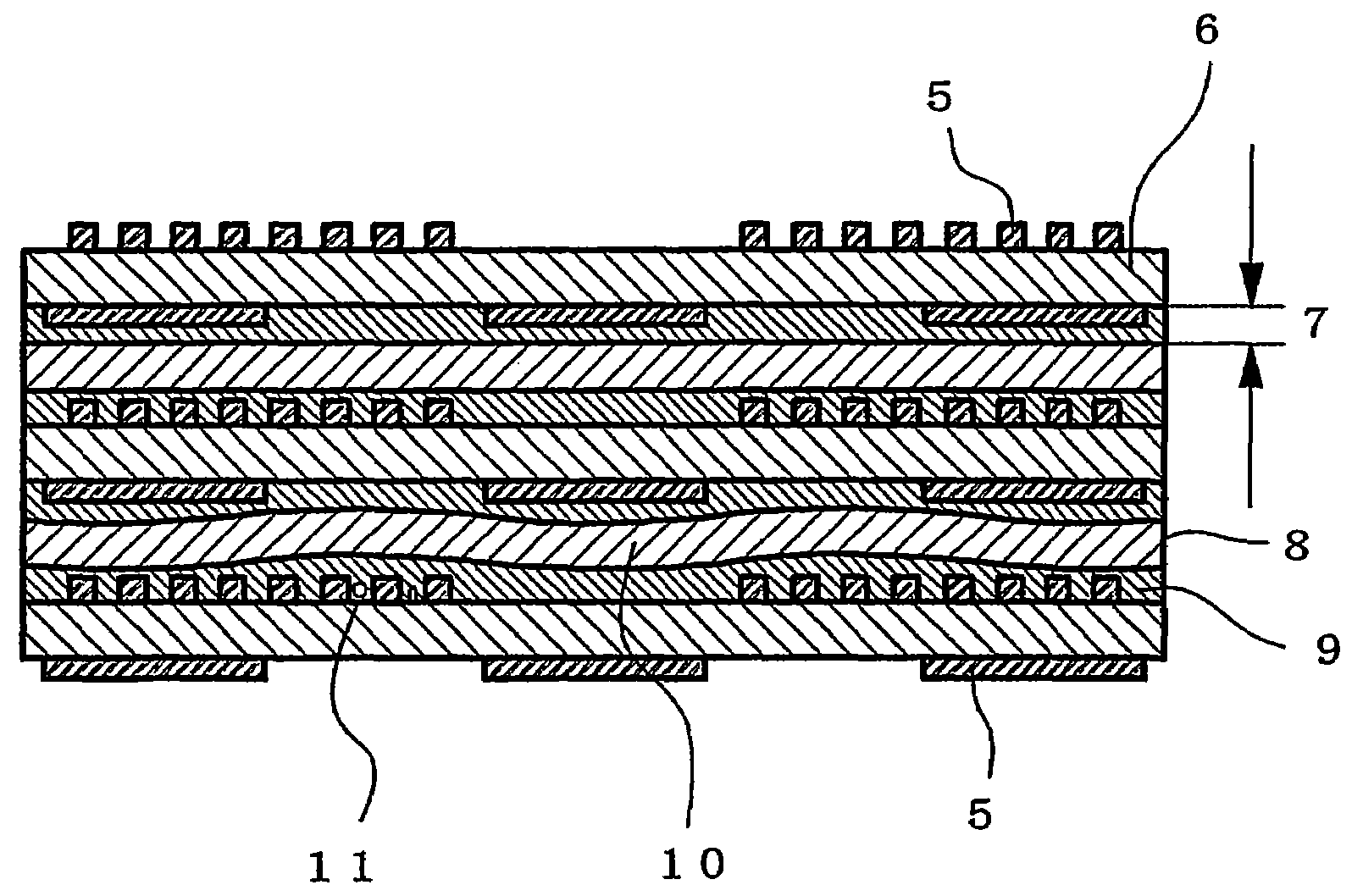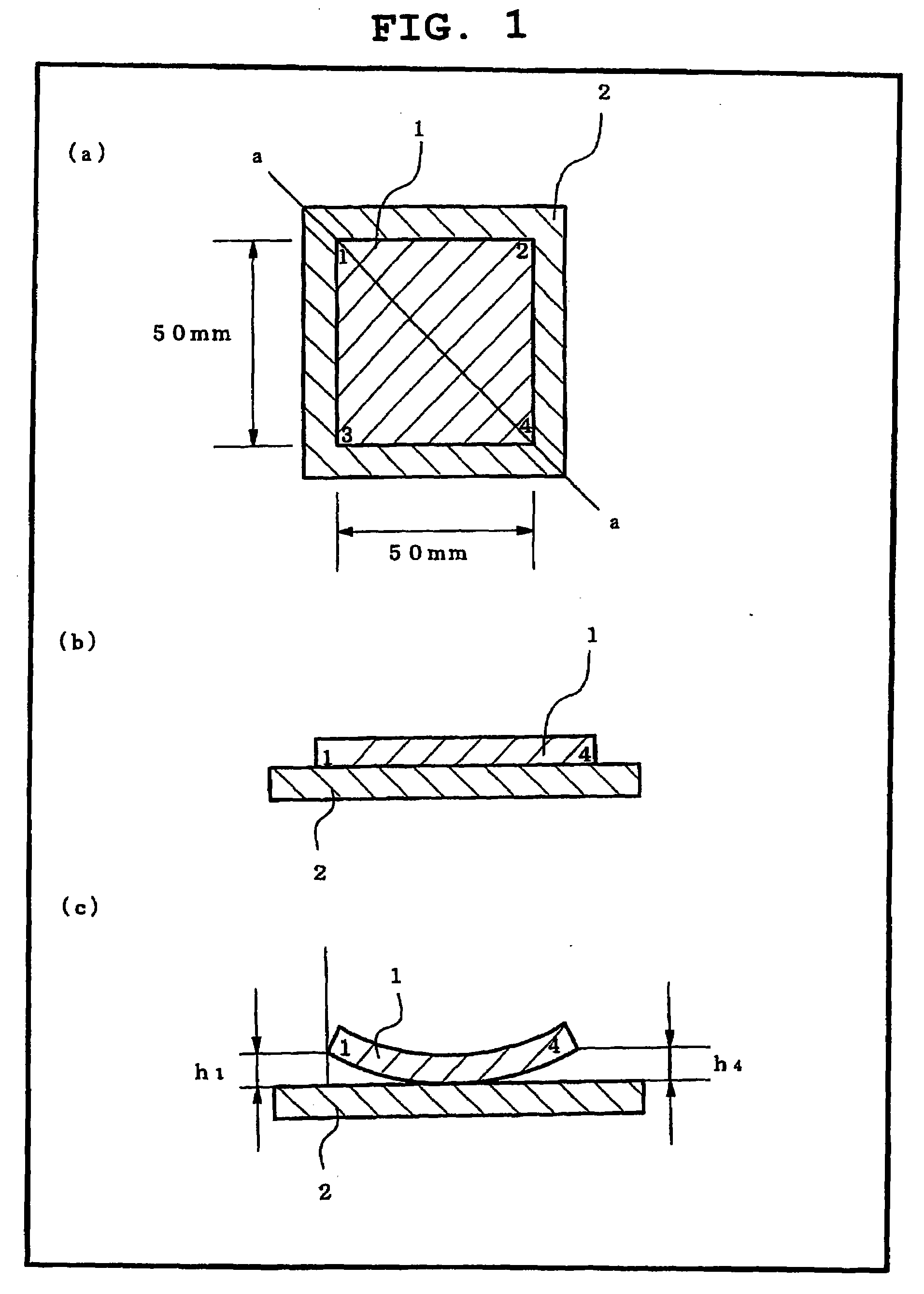Adhesive sheet, metal-laminated sheet and printed wiring board
a technology of printed circuit board and adhesive sheet, which is applied in the direction of transportation and packaging, synthetic resin layered products, chemical instruments and processes, etc., can solve the problems inability to solve, and easy occurrence of warpage and distortion, etc., to reduce the adhesion strength of flexible metal foil laminate, the effect of suppressing the gelling of polyamic acid and small molecular weigh
- Summary
- Abstract
- Description
- Claims
- Application Information
AI Technical Summary
Benefits of technology
Problems solved by technology
Method used
Image
Examples
examples
[0147]The present invention is explained in more detail in the following by referring to the Examples and Comparative Examples below, which are not to be construed as limitative. The evaluation method of the properties in the following Examples are as shown below, wherein the degree of curl after a heat treatment at 300° C. is based on the aforementioned method.
1. Thickness of Polyimide Film
[0148]A micrometer (Millitron® 1245D manufactured by FEINPRUF) was used for the measurement.
2. Degree of Warpage of Polyimide Film and Sheet (Apparent Degree of Warpage)
[0149]As shown in FIG. 1(C), a 50 mm×50 mm film test piece was stood still on a flat plane to form a concave, an average distance from each top point on the test piece to the flat plane (h1, h2, h3, h4: unit mm) was taken as the amount of warpage (mm), and a value shown by the percentage (%) of the amount of warpage relative to the distance (35.36 mm) from each top point on the test piece to the center was obtained.
[0150]Specifica...
production examples 1-3
[0163]A container equipped with a nitrogen inlet tube, a thermometer and a stirrer bar was substituted with nitrogen, and ODA was placed therein. Then, DMAC was added and, after complete dissolution, PMDA was added, and the mixture was polymerized by stirring at 25° C. for 5 hr at a molar ratio of ODA and PMDA as monomers of 1 / 1 in DMAC while adjusting the monomer charge concentration to 15 mass %. As a result, a brown viscous polyamic acid solution was obtained.
[0164]AA (15 parts by mass) and IQ (3 parts by mass) were added to the obtained polyamic acid solution (100 parts by mass), and the mixture was applied to the lubricant-free surface of a polyester film (COSMOSHINE®A4100, manufactured by Toyo Boseki Kabushiki Kaisha) having a thickness of 188 micron and a width of 800 mm, in a coating width of 740 mm (squeegee / belt gap 430 μm). The film was dried during passage through a continuous drying furnace having 4 drying zones. In each zone, 3 rows of slit-like air outlets were set fo...
production examples 4-6
[0181]Using PMDA and BPDA as an aromatic tetracarboxylic acid dianhydride component and ODA and P-PDA as a diamine component, the four kinds of monomers were polymerized at a molar ratio of PMDA / BPDA / ODA / P-PDA of 1 / 0.5 / 1 / 0.5 in DMF while adjusting the monomer charge concentration to 16 mass % to give a solution of polyamic acid in DMF. The obtained polyamic acid solution was applied to a stainless belt (gap between squeegee / belt 400 μm), and dried in the same manner as in Production Examples 1-3. By releasing the polyamic acid film that became self-supporting after the drying from a stainless belt, each green film having a thickness of 49.5 μm, i.e., Production Examples 4-6 were obtained. The value of |IMA−IMB| for respective GFs was 1.4, 4.2 and 4.8, respectively.
[0182]The obtained GFs were subjected to 2-step heating under the conditions of first step: 180° C., 3 min, temperature rise rate 4° C. / sec, second step: 460° C., 2 min, by passing the films through a nitrogen-substituted ...
PUM
| Property | Measurement | Unit |
|---|---|---|
| distance | aaaaa | aaaaa |
| flexible | aaaaa | aaaaa |
| weight | aaaaa | aaaaa |
Abstract
Description
Claims
Application Information
 Login to View More
Login to View More - R&D
- Intellectual Property
- Life Sciences
- Materials
- Tech Scout
- Unparalleled Data Quality
- Higher Quality Content
- 60% Fewer Hallucinations
Browse by: Latest US Patents, China's latest patents, Technical Efficacy Thesaurus, Application Domain, Technology Topic, Popular Technical Reports.
© 2025 PatSnap. All rights reserved.Legal|Privacy policy|Modern Slavery Act Transparency Statement|Sitemap|About US| Contact US: help@patsnap.com



